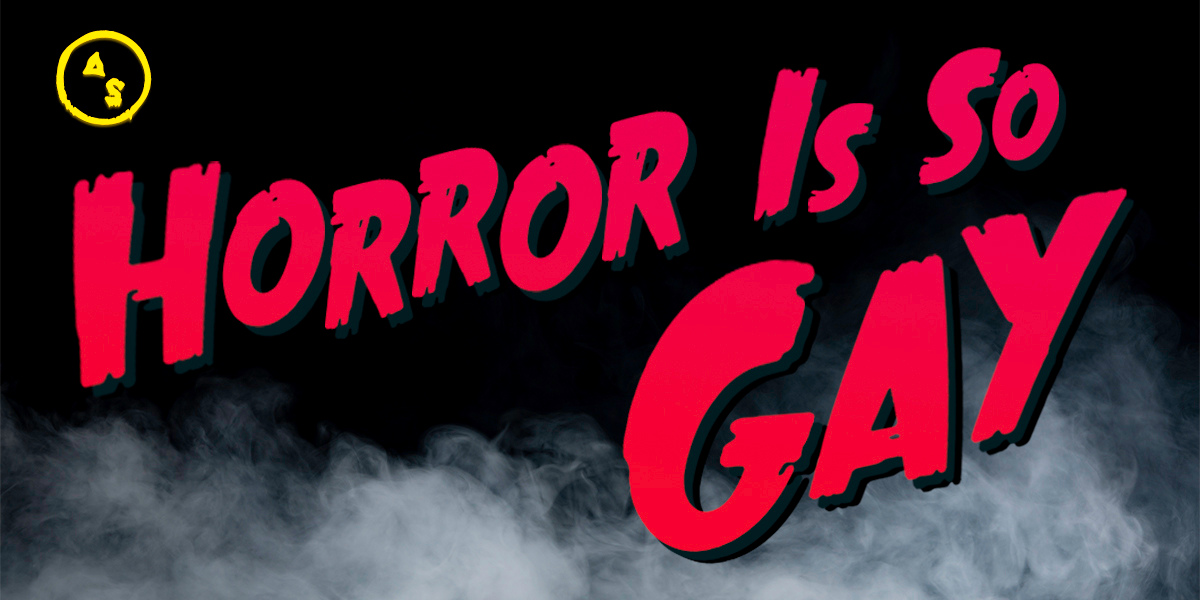
Horror Is So Gay // Header by Viv Le
Let me, for a moment, become Fright Dyke, the name I’ve given to my alter ego as a horror host, a job I believe I’d excel at. Get ready. Something’s coming. Something that will ask you to look at your fears and the fears of others. Something that will blur the lines between fear and desire. Something monstrous and lovely. Horror Is So Gay is coming, and it’s going to surprise you, maybe unsettle you, maybe make you see ghosts you couldn’t see before, maybe reveal something to you in the mirror, like a sleepover game of Bloody Mary.
To say that “queer horror” is having a moment is, at best, disingenuous and, at worst, a wilful ignorance of not only film history but also queer history and theory. Yes, this October brings with it buzzy and expansive critical works examining queerness in the horror genre. There’s the Feminist Press collection of essays It Came from the Closet: Queer Reflections on Horror, edited by Joe Vallese and featuring an essay by Carmen Maria Machado about the movie Jennifer’s Body and the limits and losses of accusing art and people of queerbaiting that we we were lucky enough to provide a sneak preview of here on Autostraddle. There’s also the new four-part Shudder documentary Queer for Fear: The History of Queer Horror, airing throughout the month. I’ll certainly be tuning in. But I think if someone were to say to me queer horror is having a moment, I’d think to myself: where have you been? Because horror has always been very, very, very queer, and queer scholars, film archivists, critics, writers, artists, and viewers have long laid claim to the genre.
But don’t take my word for it.
It’s with this core belief that horror is quite possibly the queerest genre there is that I conceived of Horror Is So Gay, a package of horror essays, lists, and criticism that dissects, guts, and consumes horror. Its name is meant to be a bit cheeky, a bit goading. When I say it in my head, it’s like Horror is So0ooo0oooo0oo Gay in my best affected horror host voice. The books, films, television series, and works that will be touched on over the next few weeks as part of this package are not necessarily explicitly textually queer. But, to me, calling a work queer has never been about the question of does it have gay people in it.
The recent Scream reboot, for example, features a queer character who wears a Pride pin, but the movie is starkly normative within its own criteria, failing to imagine anything beyond the rules and structures already determined by the other films in its franchise. Can it really, then, be queer? More recently, They/Them promised a “queer slasher,” but the resulting product feels like someone just going Let’s Make a Slasher With Queer Characters which is, I’m afraid, not the same. And positing They/Them as groundbreaking within the slasher subgenre erases two films that came before it that ultimately do more interesting things: Hellbent (2004) and Knife + Heart (2018). Both will be featured in pieces as Horror Is So Gay unfolds, along so many other movies, shows, and books across a range of horror subgenres and styles.
But I’ve wandered too far into the swamp. And I don’t want to give everything away too quickly. Horror is about the wait, isn’t it? The wait, the shadows, the absences.
Let’s just put it this way: The works of horror excavated in Horror Is So Gay count as queer horror because we say so. Because the queer and trans writers contributing to this series have found fragmented pieces of their flesh in these works or think there’s something bloody and meaty to chew on within their stories, characters, worlds.
We’ll be talking monsters, metaphors, and the macabre. Knives, fangs, and all sorts of sharp edges. I hope you’ll find at least one sentence that’ll haunt you in the pieces to come. Crawl into these dark corridors with us. Let yourself be possessed.
See you around xx
Fright Dyke
Horror Is So Gay is a series on queer and trans horror edited by Autostraddle Managing Editor Kayla Kumari Upadhyaya running throughout October.



LFG! 🖤🕯🦷✨
HI BECCA!!!!!!!
OMG! HELLO! This is giving me big embedded vibes. I’m learning how to use the internet again. IYKYK!
i’ll be sure to embed something in this package
Yes! ALL THE EMBEDS!
Yes, lets!
ahahahah love your picture
<3
“Because the queer and trans writers contributing to this series have found fragmented pieces of their flesh in these works or think there’s something bloody and meaty to chew” YES! I have never been more ready for a series in my LIFE 🦇🦇🦇
This is EXTREMELY good news over here in this horror-loving home!
So excited for this!! 😈
Fright Dyke!!
Excited for this!